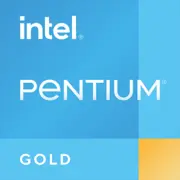Intel Pentium Gold G7400

Intel Pentium Gold G7400: Processore economico per attività quotidiane nel 2025
Architettura, prestazioni e caratteristiche da considerare
Caratteristiche principali: Alder Lake in formato compatto
Il processore Intel Pentium Gold G7400, rilasciato nel 2022, rimane una soluzione economica valida anche nel 2025. È costruito su un'architettura ibrida Alder Lake, ma, a differenza dei top di gamma Core i5/i7, utilizza solo Performance-cores (P-cores). Ecco i parametri chiave:
- Processo tecnologico: Intel 7 (10 nm Enhanced SuperFin).
- Core/Thread: 2/4.
- Frequenza: 3.7 GHz (senza Turbo Boost).
- Cache: 6 MB L3.
- TDP: 46 W.
- Grafica integrata: Intel UHD Graphics 710.
Caratteristiche dell'architettura:
- Supporto PCIe 5.0 (fino a 16 linee) e DDR5/DDR4.
- Tecnologie Intel Thread Director per l'ottimizzazione dei thread (rilevante in Windows 11/12).
- Assenza di Efficient-cores (E-cores) — focus sull'efficienza energetica grazie al numero ridotto di core.
Prestazioni:
- Geekbench 6: 2050 (Single-Core), 4405 (Multi-Core).
- Rispetto al Pentium Gold G6400 (Comet Lake, 2020): incremento del 25% nelle applicazioni single-threaded.
- Adatto per applicazioni da ufficio, navigazione e leggera gestione multitasking (ad esempio, lavoro con documenti + video in HD).
Schede madri compatibili: socket LGA 1700 e chipset
Il Pentium G7400 utilizza il socket LGA 1700, supportato dai chipset delle serie 600 e 700:
- H610: Opzione economica ($70–90). Esempi: ASUS Prime H610M-E, Gigabyte H610M S2H.
- Limitazioni: nessun overclock della RAM, 1 slot PCIe 4.0.
- B660/B760 ($100–130): La scelta migliore per G7400. Supporto DDR5 (opzionale), più porte USB/SATA. Esempio: MSI PRO B760M-P.
- H670/Z690/Z790: Eccessivi per Pentium, ma adatti per futuri upgrade.
Consiglio: Per risparmiare, scegliete H610 con DDR4. Se prevedete di passare a DDR5 — optate per B760.
Memoria supportata: DDR4 vs DDR5
Il processore è compatibile con DDR4-3200 e DDR5-4800, ma la scelta dipende dalla scheda madre:
- DDR4: Ottimale per assemblaggi economici. 16 GB (2×8 GB) DDR4-3200 costeranno tra $40 e $50.
- DDR5: Più costosa ($60–70 per 16 GB), ma offre un incremento del 5–10% nelle operazioni sensibili alla larghezza di banda (ad esempio, rendering).
Raccomandazione: Per un PC da ufficio o un media center, DDR4-3200 è più che sufficiente.
Alimentatore: calcolo della potenza
Con un TDP di 46 W e grafica integrata, un sistema con G7400 consuma ~100–150 W sotto carico. Raccomandazioni:
- Potenza PSU: 400–500 W (ad esempio, EVGA 500 BR, $45).
- Certificazione: 80+ Bronze o superiore.
- Nota: Se si prevede l'uso di una scheda video dedicata (ad esempio, GTX 1650), optate per un PSU da 500–600 W.
Pro e contro del Pentium Gold G7400
Vantaggi:
1. Efficienza energetica: Ideale per PC compatti (Mini-ITX) o sistemi con raffreddamento passivo.
2. Prezzo: $85–90 (nuovo) — uno dei processori più accessibili del 2025.
3. Tecnologie moderne: Supporto per PCIe 5.0 e DDR5 (su schede compatibili).
Svantaggi:
1. 2 core: Le operazioni multithread (videomontaggio, 3D rendering) sono lente.
2. Grafica debole: UHD 710 gestisce solo video HD e giochi più datati.
3. Nessun Turbo Boost: La frequenza fissa limita le prestazioni.
Scenari di utilizzo: dove il G7400 può esprimere il suo potenziale
1. Compiti d'ufficio: Lavoro con Excel, Word, browser (+20 schede aperte).
2. Media center: Streaming video 4K tramite HDMI 2.0, riproduzione musicale.
3. Giochi leggeri: Minecraft, Dota 2, CS:GO a impostazioni basse (30–45 FPS).
4. Server domestico: NAS o router grazie al basso TDP.
Esempio pratico:
Un utente ha assemblato un PC con G7400, ASRock H610M-ITX e 16 GB di DDR4. Il sistema è utilizzato per lavorare su documenti e guardare Netflix — il consumo energetico in modalità inattiva è di solo 25 W.
Confronto con la concorrenza: AMD vs Intel
AMD Ryzen 3 5300G ($100–110):
- 4 core/8 thread, Vega 6 (grafica più potente della UHD 710).
- Migliore nelle attività multithread (+30% in Cinebench R23), ma più costoso.
Intel Core i3-12100 ($120–130):
- 4 core/8 thread, UHD 730.
- Prestazioni superiori in giochi e applicazioni, ma il prezzo è del 40% più alto.
Conclusione: Il Pentium G7400 è vantaggioso solo nel segmento economico. Se è necessaria la multithreading, è meglio spendere di più per il Ryzen 3.
Consigli pratici per l'assemblaggio
1. Cooler: Il dissipatore stock è sufficiente, ma per un funzionamento silenzioso si consiglia il DeepCool GAMMAXX 400 V2 ($20).
2. Unità di archiviazione: Obbligatorio SSD (ad esempio, Kingston NV2 500 GB, $35).
3. Case: Va bene il compatto Fractal Design Core 1100 ($50).
4. Compatibilità: Controllate il supporto per LGA 1700 da parte del dissipatore e la disponibilità di HDMI/DisplayPort sulla scheda.
Conclusione finale: a chi è adatto il Pentium Gold G7400?
Questo processore è la scelta ideale per:
- PC da ufficio: Esecuzione rapida di documenti e del browser.
- Media center domestici: Collegamento alla TV per Netflix e YouTube.
- Assemblaggi economici: Se l'obiettivo è ridurre le spese (l'intero sistema costerà tra $300 e $400).
Perché nel 2025 è ancora attuale?
Il basso prezzo, il supporto per DDR5/PCIe 5.0 (per futuri upgrade) e l'efficienza energetica lo rendono la migliore opzione per gli utenti poco esigenti. Tuttavia, per giochi o compiti professionali è consigliabile considerare Ryzen 3 o Core i3.
Di base
Specifiche della CPU
Specifiche della memoria
Specifiche della GPU
Varie
Classifiche
Rispetto ad altre CPU
Condividi sui social media
Oppure linkaci
<a href="https://cputronic.com/it/cpu/intel-pentium-gold-g7400" target="_blank">Intel Pentium Gold G7400</a>